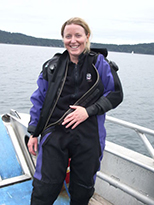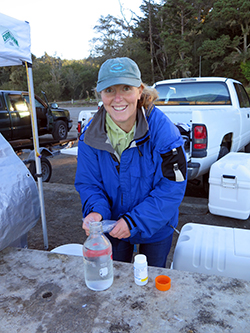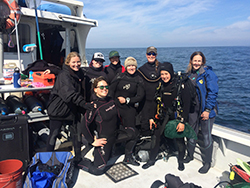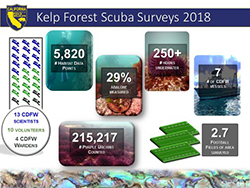Dr. Laura Rogers-Bennett is a senior environmental scientist, specialist with the California Department of Fish and Wildlife’s (CDFW) Marine Region. Based in at the Bodega Bay field office at the UC Davis Bodega Marine Laboratory, her main responsibilities are in Marine Invertebrate Fisheries and Conservation Research.

Dr. Laura Rogers-Bennett (Photo credit: Dr. Sherry Tamone)

Dr. Laura Rogers-Bennett collecting abalone samples during creel survey at Van Damme State Park, Mendocino County (Photo credit: CDFW photo)

Abalone recovery team scientists working from the southern California research vessel, R/V Garibaldi (Photo credit: Chuck Dobbins, Captain of the R/V Garabaldi)

Dr. Laura Rogers-Bennett is a senior environmental scientist, specialist with the California Department of Fish and Wildlife’s (CDFW) Marine Region. Based in at the Bodega Bay field office at the UC Davis Bodega Marine Laboratory, her main responsibilities are in Marine Invertebrate Fisheries and Conservation Research.
Laura works primarily in kelp forest ecosystems throughout the state, with a particular focus on abalone populations. She conducts research to inform the restoration of kelp forest ecosystems, including the fisheries they once supported. These include the recreational red abalone fishery in northern California and the restoration of endangered species in southern California. She also contributes to research on Dungeness crab recruitment, sea cucumbers and clam fisheries.
Laura earned her bachelor’s degree in Zoology with a Marine Emphasis at the University of New Hampshire. She went on to earn a master’s degree in Marine Biology at the University of Massachusetts/ Boston and a doctorate in Ecology at the Bodega Marine Lab, University of California, Davis.
In 1999, Laura joined CDFW where she has worked to develop a kelp forest monitoring program that is currently in its 20th year. She was also tasked with drafting the recreational red abalone fishery management plan. In 2009, Laura was awarded CDFW’s Marine Region Frances Clark Award for Excellence in Marine Science. In 2015, she was awarded a Life Membership to the International Abalone Society. And in 2017, Laura was inducted into the Women Divers Hall of Fame in 2017, where she works to expand their scholarship program and support the development of women divers.
What inspired you to become a scientist?
I have loved the ocean and animals since my earliest memories. My mother tells the story of how in kindergarten we had an assignment to draw a boat. My drawing was of a lush kelp forest with stars, snails, urchins and algae and a tiny boat at the very top of the page resting at the surface of the water. My father taught me how to snorkel and free dive. During one summer in Puerto Rico, we went spearfishing together every day for dinner. After that I decided I wanted to become a marine biologist, and I have never looked back.
What is your typical day at work like?
I don’t really have a typical workday. During field workdays, we are up very early and either go out onto the boats to dive and collect data or we go to the coast to interview fishers, measure the catch and collect data. Afterwards when we return to the lab, we are enter and examine the results and data collected in the field. This typically includes working on computers to graph the data and run statistics to see if there have been significant changes. We draft reports, create presentations and write scientific publications. I now have more than 50 peer-reviewed scientific publications. They can be found on our Marine Invertebrate Survey Project Labs webpage.
What is your favorite species to interact with or study?
I don’t really have a favorite species, although I have grown to love abalone and sea urchins. I would say one of my favorite ecosystems would be kelp forests. The algal canopy when viewed from below looks like a cathedral, and the small beautiful nudibranchs and octopus are so amazing to see. Our kelp forests are in trouble now though due to impacts by multiple climate-related stresses, such as sea star disease, the marine heat wave and the population explosion of purple sea urchins. There is  a post on our Marine blog that tells the story of how we are in the midst of The Perfect Storm.
a post on our Marine blog that tells the story of how we are in the midst of The Perfect Storm.
What is it about your work that you find the most interesting?
I enjoy the excitement of research and learning new things. We set up experiments to test important management questions. The science can be very definitive. For example, we never knew that as the water warms, there is a threshold for male red abalone above which sperm production shuts down. Clearly, this has important implications for the productivity of the fishery as it faces warm water events.
I appreciate being able to get out in the field and observe the organisms in their environment, and collecting the data myself. This gives an important perspective for the analysis of the data later. It’s important to understand the nuances in the data when we start thinking about how to translate the science into management and policy. It is a creative process where we think long and hard about what the data are telling us about how to sustainably manage our precious marine resources. I enjoy conducting use-driven science and translating that work into policy and actions.
What is the most rewarding project you’ve worked on for CDFW?
I have had so many, it’s hard to pick just one. I think the first one that comes to mind is the Kelp Forest Ecosystem Monitoring Program. This is really one of the most rewarding projects since I developed this from scratch in 1999. When I came to CDFW we had little information on which to base our red abalone management decisions. We did not have a sense of how the fishery was doing and so we instituted a fishery-independent survey of the population that included abalone competitors and predators, as well as the entire kelp ecosystem. We teamed up with our Law Enforcement Division, and that’s when things really took off. Captains Andy Roberts on the P/V Marlin and Capt. Robert Pucinelli and then Brian Bailie on the P/V Steelhead, along with their team of wardens worked with us to develop the most efficient and safe methods for working on the North Coast. In 2018, our underwater ecosystem surveys covered more than 2.7 football fields. Twenty-seven divers using seven boats dove more than 250 combined hours and counted 215,217 purple sea urchins. We did this in northern California where the ocean conditions are cold and rough, making it very challenging. We have had hundreds of scientific divers and volunteers work on board with us on these platforms supporting the science we need to manage the resources. The most rewarding part for me has been the teamwork we have where everyone is focused on the mission and working together. There are so many other exciting and productive projects, such as the restoration of the critically endangered white abalone, but that will have to be a story for another day.
If you had free reign and unlimited funding, what scientific project would you most like to do?
That’s easy: Save the kelp forest! Join us and our partners at the Noyo Science Center as part of the “Help The Kelp” campaign and check out our  Kelp Recovery Plan that was drafted in collaboration with the Gulf of the Farallones Association.
Kelp Recovery Plan that was drafted in collaboration with the Gulf of the Farallones Association.
It takes a lot of funding and expertise to address this climate change disaster. We need climate smart strategies to help us save the ecosystems and the ecosystem services we all love and depend on, such as fisheries, biodiversity and carbon sequestration. A healthy kelp forest also absorbs excess carbon helping us in so many ways.
There are many large-scale changes to ecosystems that we are seeing occur around the world. The recent mass mortality of corals in the Great Barrier Reef is one example. We just wrote a paper on mass mortalities of abalone from around the world and all the causes of these mortalities. With the more we know, the better we can act to protect these important species that we depend on. Marine heat waves are creating impacts in places around the world, such as off the western coast of Australia in 2011-2012. The loss of the bull kelp forest in northern California is another huge issue. I see it as our responsibility to respond to it. If we can bring people and data together, we can work on fully understanding the problems we are facing and identify innovative solutions.
Do you have any advice for people considering careers in science or natural resources?
Do what you love. You only get one life to live and so make it count. Don’t let anyone tell you, “you can’t do it.” No one thought I could be a scuba diver except me, and now I’m in the Women Divers Hall of Fame!
CDFW Photos. Top Photo: Dr. Laura Rogers Bennett constructing an underwater abalone recruitment cage to help scientists monitor abalone health and populations at Van Damme State Park, Mendocino County. (Photo credit: Andrew Weltz)